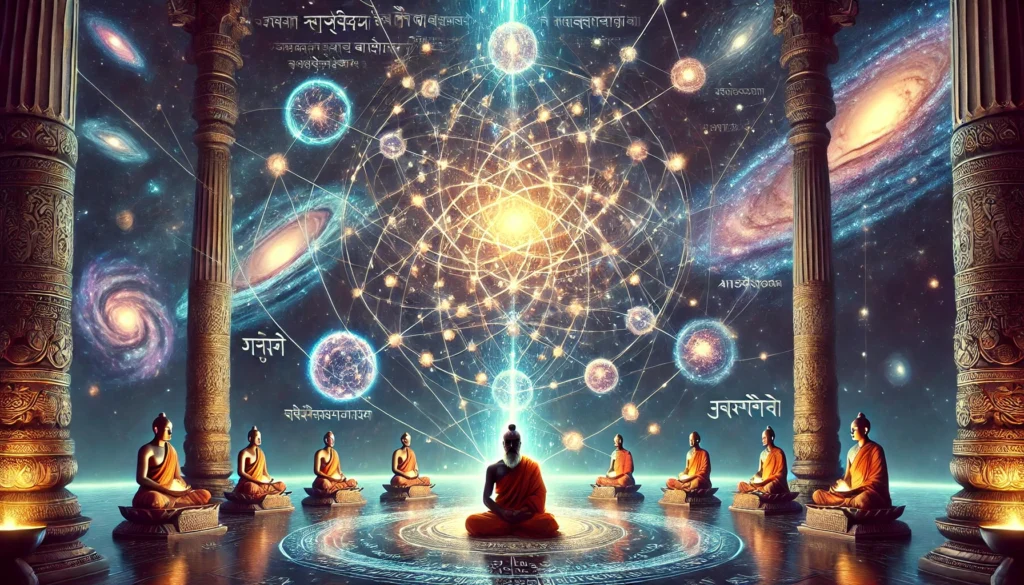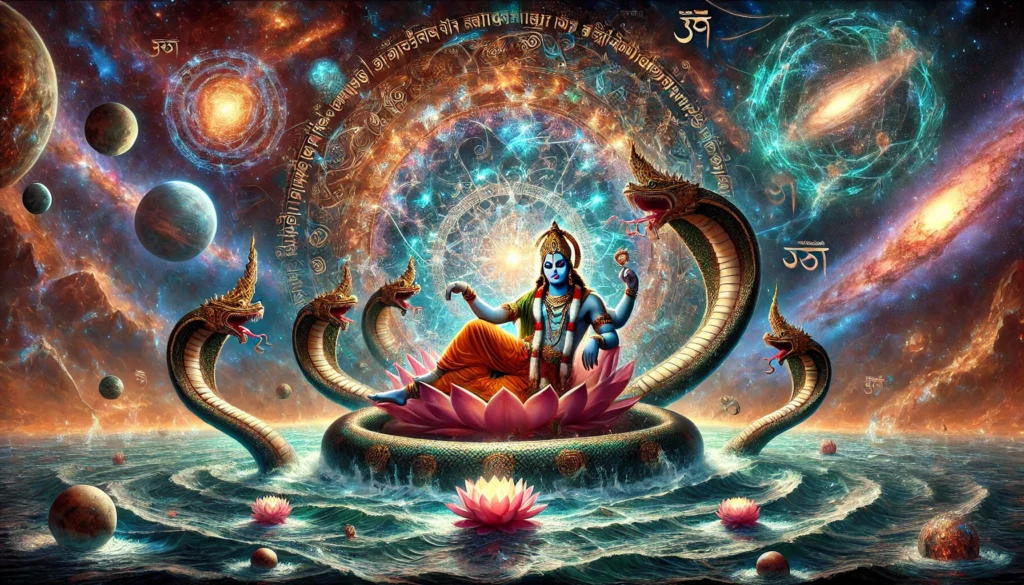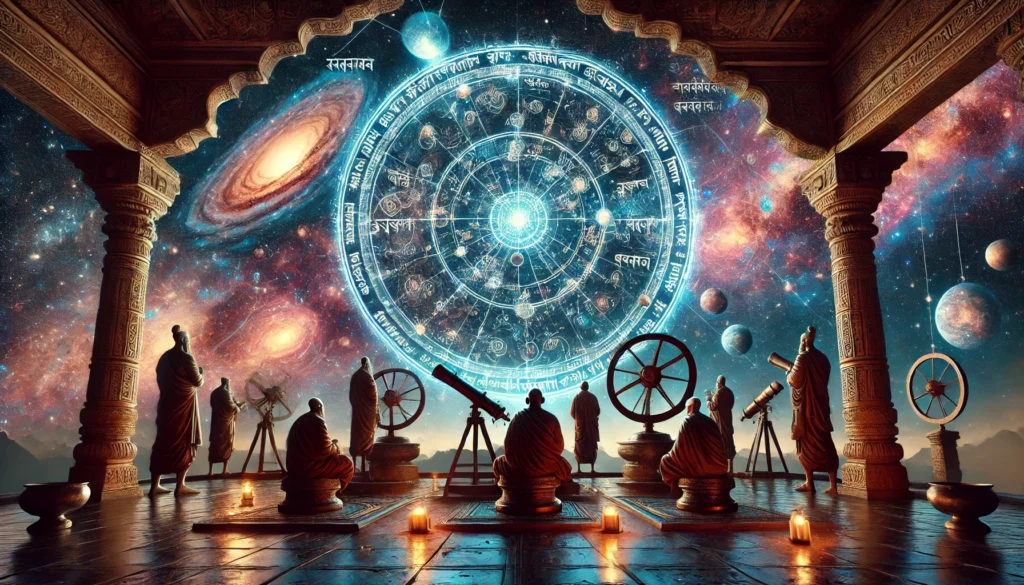Introduction
What if the keys to understanding modern scientific phenomena were hidden in texts written thousands of years ago? Could the ancient sages of Sanatana Dharma have accessed universal truths that align with today’s scientific discoveries? This intriguing possibility invites us to delve deep into the Vedas, the oldest sacred texts of India.
Sanatana Dharma, often translated as the “eternal way,” is more than a religion—it’s a comprehensive way of life. Central to this philosophy are the Vedas, ancient scriptures that encompass profound spiritual teachings and surprisingly advanced scientific knowledge. These texts touch upon astronomy, mathematics, medicine, physics, and more, offering insights that seem remarkably prescient.
In this extensive exploration, we’ll uncover the mysteries of the Vedas and how they correlate with modern science. From the cosmic hymns of the Rigveda to the medical wisdom of the Atharvaveda, we’ll journey through time to understand how ancient knowledge continues to resonate—and even find validation—in today’s world.

The Scientific Basis of the Vedas
Eternal Knowledge Encoded
The Vedas—comprising the Rigveda, Yajurveda, Samaveda, and Atharvaveda—are considered the oldest scriptures of Hinduism, dating back over 3,000 years. They are deemed śruti, meaning “that which is heard,” signifying knowledge revealed to ancient sages (rishis) through deep meditation and spiritual insight.
The Rigveda, the oldest of the four, begins with hymns that contemplate the origins of the universe. The “Nasadiya Sukta” (Rigveda 10.129) is a prime example:
“Then even nothingness was not, nor existence.
There was no air then, nor the heavens beyond it.
What covered it? Where was it? In whose keeping?
Was there then cosmic water, in depths unfathomed?”
This hymn ponders the state of the cosmos before creation, mirroring modern scientific questions about the universe’s inception. The abstract contemplation of existence and non-existence parallels the scientific exploration of matter and antimatter, and the conditions preceding the Big Bang.
Atharvaveda and Practical Science
The Atharvaveda is particularly rich in references to practical sciences. Often called the “Veda of magical formulas,” it encompasses knowledge related to everyday life, including medicine, agriculture, and astronomy.
For instance, the Atharvaveda contains hymns that detail the use of herbs and natural remedies, forming the foundation of Ayurveda, the ancient Indian system of medicine. It also discusses the properties of natural elements, hinting at an early understanding of chemistry and physics.
“Herb of herbs, the all-healing, healing all the ailing,
this is the remedy for fever,
this drives out disease.”
(Atharvaveda 2.8.3)
This emphasis on natural healing and preventive medicine is a cornerstone of holistic health practices today.
Scientific Concepts in the Vedas
Astronomy and Cosmology
The Vedas exhibit a sophisticated grasp of astronomical phenomena. The Rigveda and subsequent texts like the Surya Siddhanta provide detailed observations of celestial bodies.
Heliocentrism and Planetary Motion
The idea that the Earth revolves around the Sun—a heliocentric model—was acknowledged in Vedic texts long before it became mainstream in Western science.
“The sun strings these worlds—
the earth, the planets, the atmosphere—
to himself on a thread.”
(Rigveda 1.35.9)
The “Aitareya Brahmana” (3.44) suggests knowledge of planetary movements:
“The sun never sets nor rises;
when people think the sun is setting,
it is not so; for after having arrived at the end of the day,
it makes itself produce two opposite effects,
making night to what is below and day to what is on the other side.”
This reflects an understanding of the Earth’s rotation and the concept of time zones.
Cosmic Cycles and Time Measurement
Vedic literature introduces the concept of vast cosmic cycles, known as Yugas, which span millions of years. The calculation of these cycles demonstrates an advanced comprehension of astronomical time scales.
- Krita Yuga (Satya Yuga): 1,728,000 years
- Treta Yuga: 1,296,000 years
- Dvapara Yuga: 864,000 years
- Kali Yuga: 432,000 years
These cycles total 4.32 million years, known as a Mahayuga. A thousand Mahayugas constitute a Kalpa, which equals one day of Brahma, the creator god—a timespan of 4.32 billion years, intriguingly close to the current scientific estimate of Earth’s age.
Mathematics
The Concept of Zero and Decimal System
The invention of zero (shunya) as both a numerical value and a placeholder is attributed to ancient Indian mathematicians, with its earliest use found in Vedic texts.
“Subtract a fact from a fact,
the remainder is zero.”
(Brahmagupta’s Brahmasphutasiddhanta)
The decimal system, based on powers of ten, is evident in the way numbers are expressed in Sanskrit.
Geometry and the Sulba Sutras
The Sulba Sutras, appendices to the Vedas dating from 800-500 BCE, are among the earliest texts on geometry. They provide methods for constructing altars and fire places with precise measurements.
One famous theorem resembles the Pythagorean theorem:
“The diagonal of a rectangle produces
an area equal to that produced
by the vertical and horizontal sides.”
(Baudhayana Sulba Sutra 1.12)
This predates Pythagoras by several centuries.

Ayurveda: The Science of Life
Ayurveda, meaning “the science of life,” originates from the Atharvaveda. It encompasses a holistic approach to health, emphasizing balance among body, mind, and spirit.
The Tridosha Theory
The fundamental principle of Ayurveda is the concept of Tridosha—the three biological energies:
- Vata (Air and Ether): Governs movement and communication.
- Pitta (Fire and Water): Controls digestion and metabolism.
- Kapha (Earth and Water): Provides structure and lubrication.
Imbalance among these doshas leads to illness. Treatments focus on restoring harmony through diet, herbal remedies, and lifestyle changes.
Surgical Techniques
Sushruta Samhita, an ancient surgical text, describes numerous surgical procedures, including rhinoplasty (nose reconstruction), which is considered one of the earliest forms of plastic surgery.
“A portion of skin measuring up to the size of the severed or clipped part should be sliced off from the cheek, and swiftly adhered to the nose.”
(Sushruta Samhita, Chapter XVI)
These advanced techniques highlight a sophisticated understanding of human anatomy and medical procedures.
Physics and Energy

Atomic Theory
The concept of the atom (anu) and the idea that matter is composed of tiny, indivisible particles are present in Vedic texts.
“All objects in the universe are composed of minute particles.
These particles cannot be seen with the naked eye
and are in perpetual motion.”
This aligns with the modern atomic theory and the understanding of molecular motion.
Energy and Matter Interchangeability
Vedic philosophy often discusses the interchangeability of energy and matter, a concept central to Einstein’s theory of relativity.
“Brahman is the ultimate reality—
pure consciousness and energy,
from which all matter arises.”
This reflects the idea that energy manifests as matter, and both are fundamentally the same at the core.
Parallels Between Modern Science and Vedic Knowledge
Cosmology and the Big Bang Theory
The Vedic description of the universe’s origin bears resemblance to the Big Bang Theory.
Creation Hymns and Cosmic Egg
The “Hiranyagarbha Sukta” (Rigveda 10.121) introduces the concept of the Golden Egg or Cosmic Egg from which the universe originates.
“In the beginning was the Golden Womb—
Hiranyagarbha, born of the primordial waters,
He who is the one lord of all that exists.”
This parallels the idea of a singular, dense point from which the universe expands.
Cyclical Creation and Destruction
The Vedic notion of cyclical creation and dissolution (Srishti and Pralaya) aligns with modern theories about the cyclical nature of the universe, including the Big Crunch and Big Bounce hypotheses.
Quantum Physics and Consciousness
Observer Effect
In quantum mechanics, the observer effect suggests that the act of observation alters the state of a particle. Vedic texts emphasize the role of consciousness in shaping reality.
“You are what your deep, driving desire is.
As your desire is, so is your will.
As your will is, so is your deed.
As your deed is, so is your destiny.”
(Brihadaranyaka Upanishad 4.4.5)
This underscores the influence of consciousness on the material world.
Non-Locality and Interconnectedness
The Vedic principle of Advaita (non-duality) states that all existence is one unified reality.
“Sarvam Khalvidam Brahma”
“All this is verily Brahman.”
(Chandogya Upanishad 3.14.1)
This mirrors the quantum concept of entanglement, where particles remain connected regardless of distance.
Environmental Science
Sustainability and Ecology
Vedic literature emphasizes living in harmony with nature.
“The Earth is our mother,
and we are her children.”
(Atharvaveda 12.1.12)
This personification of Earth promotes environmental stewardship, aligning with modern ecological principles.
Five Elements and Environmental Balance
The concept of Pancha Mahabhuta—the five great elements (Earth, Water, Fire, Air, Ether)—highlights the interconnectedness of natural elements and the importance of maintaining balance among them.
Practical Applications of Vedic Science

Yoga and Mind-Body Balance
Yoga, originating from the Vedas, is a comprehensive system for achieving physical, mental, and spiritual well-being.
Eight Limbs of Yoga
Outlined by Patanjali in the Yoga Sutras, the eight limbs provide a path to enlightenment:
- Yama: Ethical standards
- Niyama: Self-discipline
- Asana: Physical postures
- Pranayama: Breath control
- Pratyahara: Withdrawal of senses
- Dharana: Concentration
- Dhyana: Meditation
- Samadhi: Union with the divine
Modern science recognizes the benefits of yoga in reducing stress, enhancing mental clarity, and improving physical health.
Renewable Energy
Harnessing Solar Power
The Vedas acknowledge the sun as the primary source of energy.
“Surya Atma Jagatas Tasthushas Cha”
“The sun is the soul of all that moves and stands still.”
(Rigveda 1.115.1)
This reverence for solar energy aligns with contemporary efforts to harness solar power as a renewable energy source.
Wind and Water Energy
Vedic rituals often honor Vayu (wind) and Varuna (water), recognizing their vital roles.
“May the winds blow sweetly,
may the rivers flow sweetly,
may the herbs be sweet unto us.”
(Rigveda 1.90.6)
This appreciation supports the sustainable use of wind and hydro energies.
Harmony with Nature

Agricultural Practices
Vedic texts provide guidelines for sustainable agriculture, including crop rotation and organic farming.
“Upon this handful of soil our survival depends.
Care for it, and it will care for you.”
These practices enhance soil fertility and promote ecological balance.
Animal Welfare
The Vedas advocate for the respectful treatment of animals.
“One should not cause injury to living beings
at any time through the actions of one’s mind, speech, or body.”
(Manusmriti 4.246)
This principle resonates with modern movements against animal cruelty and for ethical treatment.
Relevance of Vedic Science Today
Ayurveda’s Resurgence
Holistic Health
Ayurveda’s emphasis on prevention and personalized care is increasingly relevant as people seek alternatives to conventional medicine.
- Immunity Boosting: Ayurvedic herbs like turmeric and ashwagandha are recognized for their immune-enhancing properties.
- Mental Health: Techniques like meditation and mindfulness stem from Vedic practices and are widely adopted for stress management.
Education and Philosophy
Mindfulness and Ethics in Education
Incorporating Vedic principles into education fosters ethical behavior and emotional intelligence.
“Education is the manifestation of perfection already in man.”
(Swami Vivekananda)
This holistic approach nurtures well-rounded individuals.
Interdisciplinary Research
Neuroscience and Meditation
Studies show that meditation alters brain structure and function, improving cognitive abilities and emotional regulation.
- Neuroplasticity: Regular meditation increases gray matter density.
- Stress Reduction: Decreased activity in the amygdala leads to lower stress responses.
Artificial Intelligence and Consciousness
Explorations into artificial intelligence draw parallels with Vedic concepts of consciousness and self-awareness.
“The Self is the innermost essence,
the seer behind all thoughts.”
Understanding consciousness from a Vedic perspective may inform AI development.
Conclusion
The Vedas, integral to Sanatana Dharma, are more than ancient scriptures; they are timeless repositories of wisdom that bridge spirituality and science. Their profound insights into the nature of reality, the cosmos, and human existence continue to be relevant, offering guidance in a rapidly changing world.
By revisiting these ancient texts, we not only honor a rich cultural heritage but also uncover solutions to modern challenges—be it in health, environmental sustainability, or understanding the universe.
Could it be that the future of science and human progress lies in the wisdom of our ancient past? The Vedas invite us to explore this possibility, encouraging a harmonious blend of tradition and innovation.
FAQs
1. What is the connection between Vedic texts and science?
The Vedas contain hymns and passages that reflect advanced understanding in various scientific fields:
- Astronomy: Descriptions of planetary movements and cosmic cycles.
- Mathematics: Concepts of zero, decimal system, and geometry.
- Medicine: Foundations of Ayurveda, emphasizing holistic health.
- Physics: Ideas about atoms, energy, and the nature of reality.
These insights suggest that ancient sages observed and contemplated natural phenomena deeply, encoding their findings in poetic and symbolic language.
2. What does Vedic cosmology say about the universe?
Vedic cosmology presents a cyclical universe with infinite creation and dissolution phases. Key concepts include:
- Hiranyagarbha (Cosmic Egg): The universe originates from a singular source.
- Yugas and Kalpas: Vast time cycles that measure cosmic events.
- Multiverse Theory: References to multiple universes or planes of existence.
These ideas parallel modern cosmological theories about the Big Bang, cyclic models, and the multiverse.
3. How is Ayurveda relevant today?
Ayurveda’s holistic approach addresses physical, mental, and spiritual health:
- Preventive Care: Focus on lifestyle and diet to maintain balance.
- Natural Remedies: Use of herbs and minerals with medicinal properties.
- Personalized Treatment: Tailoring therapies to individual constitutions (doshas).
Its principles align with contemporary trends in wellness and integrative medicine.
4. Did ancient sages understand advanced science?
While it’s unlikely that ancient sages had technology comparable to modern instruments, they achieved profound insights through observation, meditation, and contemplation.
- Symbolic Representation: Knowledge was encoded in metaphors and allegories.
- Intuitive Understanding: Deep connection with nature led to advanced conceptualizations.
Their methodologies differ from modern scientific methods but offer valuable perspectives.
5. Can Vedic knowledge contribute to modern science?
Absolutely. Vedic knowledge can:
- Inspire New Ideas: Philosophical concepts may stimulate innovation.
- Promote Sustainability: Emphasizing harmony with nature aids environmental efforts.
- Enhance Well-being: Holistic health practices improve quality of life.
Collaborations between scientists and scholars can bridge ancient wisdom with contemporary research.
Are you intrigued by the connections between ancient wisdom and modern science? Share your thoughts in the comments below and join the conversation!
